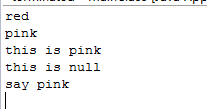使用枚举enum
枚举可以把常量按照类别组织起来, 并且提供了构造方法和其他访问方法
用法:
package com.nel.testPro.useage.use_enum; public enum Color implements Behaviour{ RED, YELLOW, BLUE, PINK("pink", 3); // 使用枚举, 可以将常量分类, 而且能提供比操作常量跟更多的方法 // 自定义属性 private String name; private Integer index; public String getName() { return name; } public void setName(String name) { this.name = name; } public Integer getIndex() { return index; } public void setIndex(Integer index) { this.index = index; } Color () { } // 自定义构造方法 Color(String name, Integer index) { this.name = name; this.index = index; } // 普通方法 public static String getName(Integer index) { for (Color c : Color.values()) { if (c.getIndex() == index) { return c.getName(); } } return "not found"; } // 覆盖toString @Override public String toString() { return "this is " + this.name; }
// 可以实现接口, 扩展其方法 @Override public void say() { System.out.println("say " + this.getName()); } }
测试:
public static void main(String[] args) { Color color = Color.RED; switch(color) { case RED: System.out.println("red"); break; case BLUE: System.out.println("blue"); break; case YELLOW: System.out.println("yellow"); break; case PINK: System.out.println("pink"); } // System.out.println(Color.getName(3)); // System.out.println(Color.valueOf("PINK")); // System.out.println(Color.valueOf(Color.class, "BLUE")); // Color.PINK.say(); }
输出:





 浙公网安备 33010602011771号
浙公网安备 33010602011771号